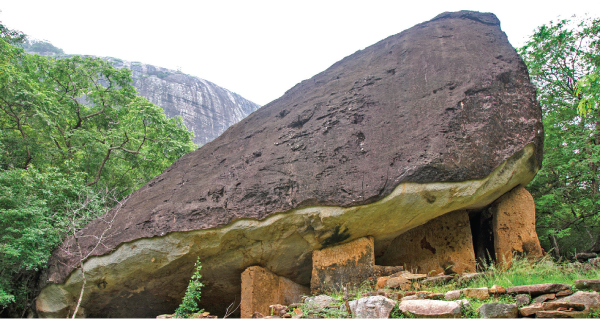
We could see the silhouette of the Dimbulagala mountain range with its jagged peaks thrusting against the pale blue sky. The air was a little chilly.
The placid water of the Dalukana tank could be seen on the left side of the road, lying at the foot of the Dimbulagala hill. 
Across the tank, a soft, cool breeze blew through the leaves of the trees. The shade and the soothing swishing sound of leaves mesmerised us.
Destination
Our destination was the Namal Pokuna Purana Raja Maha Vihara, in Dalukana, often referred to as an Adivasi (Veddha) village, 10 km from Manampitiya, an ancient Adivasi village, which was home to one of the earliest Adivasi clans.
We were at the Namal Pokuna Raja Maha Vihara, Dalukana, with the expectations of meeting Adivasi Ven. Millane Sri Siriyalankara Thera, who resided in the temple where Adivasis have left marks of their civilisation in caves, most of which have vanished.
 |
| Ven. Millane Sri Siriyalankara Thera, Chief Incumbent of Dimbulagala hermitage |
The history of Namal Pokuna, which had sheltered thousands of bhikkhus in the past, dates back to the reign of King Pandukabhaya. It had been overgrown with creepers after the Chola invasion and had later become a home for the Adivasi.
Gift of natural caves
Millana Yapa, the last chieftain of the clan who lived in the caves in the Dimbulagala forest had decided to gift all the natural caves to a bhikkhu along with 12 Adivasi boys, to be ordained as samanera bhikkhus. Ven. Millane Sri Siriyalankara Thera, Viharadhipathi of the Dimbulagala forest hermitage, was one of these boys.
“The caves were gifted to Ven. Matara Kithalagama Sri Seelalankara Thera by my father, Millana, who was the chieftain of the Adivasi clan in Dimbulagala.
The caves where we lived became Buddhist shrines and dwelling places of meditating bhikkhus,” said Ven. Siriyalankara Thera “The Viharadhipathi built a school for us in Horiwila. It was an enjoyable life in school,” he said.
They carried a slate and a slate-pencil to school those days.
Returning from school at noon, they would have a dip in the village tank under the scorching sun, an enthralling experience for the children.
The Namal Pokuna ancient site in Dalukana was founded by the late Ven. Sri Seelalankara Nayaka Thera, who took the lead to protect the lives of the poor in the border villages during LTTE terrorism. The Thera, popularly known as, Dimbulagala Hamuduruwo was gunned down by the LTTE in the hermitage in 1995.
Namal Pokuna archaeological site
After the conversation with Ven. Siriyalankara Thera, we returned to the Namal Pokuna Raja Maha Vihara where we began our exploration from the Namal Pokuna archaeological site at the foothills of the Dimbulagala mountain range. The path uphill was dotted with rocky boulders, interspersed with tall, shady forest canopy.
Exploring the caves and stone ruins that have made Namal Pokuna famous, we came across a torso of the Buddha statue, believed to be in an image house of the hermitage, a series of brick stupas, stone pillars and stone walls resting almost on each other on the flat plain. A little further away, we encountered several drip-ledged caves with ancient walls believed to be occupied by monastic bhikkhus in the hermitage in the past.
We lost ourselves in the beauty of the ruins and wondered how these hermitages were destroyed. Perhaps, they met their end with foreign invasions which pulled down the monuments. If you are a history buff, the serenity you experience is well worth making a stop in the Namal Pokuna archaeological site in the Dimbulagala mountain range.
 |
| The ruins of the structure at Namal Pokuna |
 |
| The Kashyapa Lena |
